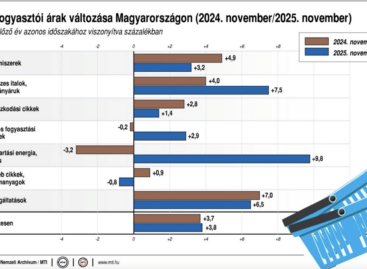Average gross earnings can be misleading: there are significant earnings inequalities in Hungary
The Central Statistical Office (KSH) regularly publishes the gross average earnings, but this data often does not reflect the real income situation, as it masks inequalities. The earnings data broken down by income deciles requested by Portfolio.hu revealed that 66.5 percent of employees earn less than the national gross average earnings. The GKI Economic Research Institute examined how the total earnings are distributed among the income deciles.
The highest earners receive the largest share of the earnings
 According to GKI calculations, the highest earning 10 percent of full-time workers take home more wages than the bottom 50 percent combined. The lowest earning decile accounts for only 3.5 percent of the total earnings, while the top decile owns 28.1 percent – an eightfold difference. The second richest decile also has only half the share of the top decile.
According to GKI calculations, the highest earning 10 percent of full-time workers take home more wages than the bottom 50 percent combined. The lowest earning decile accounts for only 3.5 percent of the total earnings, while the top decile owns 28.1 percent – an eightfold difference. The second richest decile also has only half the share of the top decile.
The impact of income inequality on consumption
According to the GKI analysis, such a distribution of income also has a significant impact on consumption habits. It is a basic economic principle that lower earners spend a larger part of their income on consumption, while high earners have a higher saving rate. Significant income differences therefore have an adverse effect on retail sales and consumption growth.
The income gap increased in 2024
As a result of the minimum wage increase in 2024, the percentage increase in the bottom decile of income was higher (10-15%) than in the top decile, but the differences increased further in nominal terms. The monthly gross earnings of those working in the bottom decile increased by 29,500 forints, while the same amount was 166,600 forints in the top decile.
As a result, the weight of the top three earnings deciles within the total earnings mass increased from 48 percent to 54 percent from 2023 to 2024.
Inequality also affects economic growth
According to the GKI, the distortion of the distribution of earnings has several unfavorable effects. A larger part of the income generated by high earners appears as savings, while low earners are less able to increase their consumption. This results in earnings inequalities holding back the expansion of domestic consumption, which is also a significant factor in terms of economic growth.
The issue of significant income differences thus remains an important economic and social challenge in Hungary.
Related news
The price of slaughter pigs has decreased in Hungary and in the EU
🎧 Hallgasd a cikket: Lejátszás Szünet Folytatás Leállítás Nyelv: Auto…
Read more >EU egg imports increased by one and a half times
🎧 Hallgasd a cikket: Lejátszás Szünet Folytatás Leállítás Nyelv: Auto…
Read more >KSH: in November, consumer prices exceeded the values of the same month of the previous year by an average of 3.8 percent
🎧 Hallgasd a cikket: Lejátszás Szünet Folytatás Leállítás Nyelv: Auto…
Read more >Related news
Challenges of the retail sector: retail has become more crisis-resistant
🎧 Hallgasd a cikket: Lejátszás Szünet Folytatás Leállítás Nyelv: Auto…
Read more >How to avoid the hassles of online shopping?
🎧 Hallgasd a cikket: Lejátszás Szünet Folytatás Leállítás Nyelv: Auto…
Read more >It’s time for company Christmas parties: a waste of money or a good party?
🎧 Hallgasd a cikket: Lejátszás Szünet Folytatás Leállítás Nyelv: Auto…
Read more >






